On my previous trip to Japan in 2017 I purchased a sukajan – the Japanese-style embroidered silk bomber jacket. For my next trip to Japan in 2018 I wanted to pick up something similarly iconic. After searching the internet and SoraNews24 I settled on something from Sou Sou Kyoto, a store that specializes in traditional Japanese clothing with a modern twist. After going through all of their offerings I settled on purchasing a pair of their jikatabi sneakers.
Everybody Wants to be a Ninja
Many people are familiar with tabi socks/shoes as the preferred footwear of ninja. The iconic split toe footwear traces its origins to the fact that ancient Japanese people wanted to wear socks with their flip-flops (or geta/zori). Jikatabi are actually a fairly modern invention, being created in the 1930s by Tokujiro Ishibashi, the brother of the founder of the Bridgestone tyre company which actually made jikatabi before they branched off into making car tires and car parts (Fun Fact: If you were wondering why a Japanese company has an English name, it is because Bridgestone is an English translation of the founder’s last name Ishibashi. ishi = stone / bashi = bridge). Jikatabi literally mean tabi which touch the ground. Tokujiro essentially took the traditional tabi sock (now replaced with heavy cloth) and added a rubber sole to the bottom. Traditional jikatabi are latched at the back and initially came in boot form.
Contrary to popular belief, jikatabi are more commonly worn by farmers, gardeners and construction workers even now. On my last trip I saw a few construction workers wearing jikatabi. They are particularly good in these professions as the thin, flexible rubber sole and separation of the big toe from the other toes allows the feet better grip and maneuverability, particularly on uneven surfaces. For this reason they are also used in martial arts. However the idea that ninja wore jikatabi is more or less a modern Hollywood fabrication. More than likely they wore tabi socks with zori like most of the lower classes did at that time.
In the latter part of the 20th century jikatabi have been worn more as casual footwear, eventually being adapted as jikatabi sneakers which replace the traditional metal latches at the back with laces at the front. Various sneaker companies outside of Japan such as Nike have released jikatabi sneakers over the years and jikatabi have more than likely influenced the minimalist running footwear like the Vibram FiveFinger sneakers.
Arranging the Purchase
The jikatabi sneakers offered by Sou Sou Kyoto are created in collaboration with French sportswear company Le Coq Sportif and have their own dedicated store in Kyoto called Sou Sou Le Coq Sportif. As the company name suggests, their main store locations are in Kyoto. The only other locations are in San Francisco in the US and the Aoyama store in Tokyo. In addition, their jikatabi sneakers are only sold at the Sou Sou Le Coq Sportif store. Since I wasn’t going anywhere near Kyoto on my last trip, I arranged for Sou Sou to send the jikatabi sneakers from the Kyoto to the Aoyama store. A few weeks before my trip I emailed Sou Sou to see if this was possible. Using my greatly improved Japanese language skills and Google Translate, I was able to communicate with them via email as to which items I was looking to purchase and had them send the items to the Aoyama store for me to try when I arrived.

A few notes on purchasing any clothing in Japan as a Westerner – you need to size up. I made this mistake on my first trip to Japan when buying a football jersey. I typically wear a medium shirt so purchased a medium jersey. When I went to try it on later that day, it fit me more or less like a compression shirt. It was wearable but not really the fit I was looking for. Japanese people in general are smaller in height and girth so their sizing reflects this. As a result any future T-shirt purchases I made were size large. Because of this I had always avoided trying to buy footwear in Japan. I wear a size 11.5 shoe (US size) and typically purchase size 12 as many shoe stores don’t often carry half sizes. The largest size Sou Sou go up to for their jikatabi is 29 cm which is equivalent to a US size 11. In reality 29 cm is closer to a size 11.5 so I was fairly sure their largest size would fit me (it did). In addition to buying the shoes, I also needed to buy tabi socks. Jikatabi sneakers are essentially minimalist shoes in that they have a very thin sole and almost no heel. They are built like a pair of old school Converse sneakers – no padding in the sole and no arch support. As a result I decided to buy Cushion Pile Tabi Socks to give me that extra bit of cushion when I wear them. The problem was that their largest size sock is only 28 cm or a true size 11 which I was pretty sure wouldn’t fit me. The socks did fit me when I tried them on but they are a very tight fit and can be uncomfortable. A few months later I purchased four pairs of larger tabi socks from Amazon. Although the socks are sized for 6-11, enough of the reviews said they would fit size 12 so I was comfortable in purchasing them. Later on I would re-purpose those Sou Sou tabi socks to use as my socks with my winter pajamas. The black and blue pairs I bought coincidentally perfectly matched my black and blue winter pajama sets. They are still tight but have stretched over time.
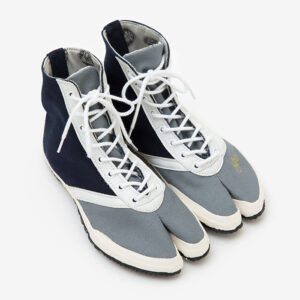
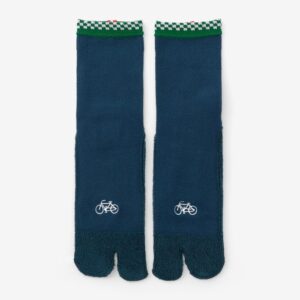
How Do They Feel
I haven’t worn flip flops since I was a kid, so the biggest transition for me was adjusting to the feeling of having something jammed between your big toe and the second toe. In addition I needed to readjust to wearing shoes without the usual memory foam insoles and arch support. The thin soles mean you do feel nearly every rock and pebble beneath your feet. Once I had the bigger tabi socks from Amazon, wearing them is pretty comfortable. They are definitely a conversation starter when people see you wearing them.
When Your Shoes Let You Down
If you are wearing your shoes on a regular basis (or conversely if you rarely wear your shoes) they will begin to break down after about seven years. This could be anything from the stitching coming loose or the glue on the soles giving out. I have made the mistake of ignoring this rule on three occasions with catastrophic outcomes. The first time, I was wearing a pair of well-worn 6-year-old sneakers while walking around Juneau, Alaska when the sole on one the shoes began to fall off. Fortunately I had just purchased a pair of hiking boots a few days prior (Travel Tip: Always travel with two pairs of shoes – one you wear and one in your luggage. You never know what may happen.). The second incident occurred with a pair of semi-casual brown work shoes. Although the shoes were only about four or five years old, I had rarely worn them. At the time I would walk about a mile to and from work. When I finally decided to wear the shoes one day, on my way home bits and pieces of the soles began falling away. By the time I reached home there was very little sole left as the rubber had become brittle due to lack of use. The following website explains why not wearing your shoes can be just as bad on the lifespan of your shoes as wearing them too often. The final incident occurred with a pair of really old Air Jordans. The soles began falling off while walking around town. It was pretty bad and somewhat embarrassing as the front of the sole flapped around as I walked. Needless to say I began rigorously tracking the ages of all of my shoes with an eye to not exceeding that seven year mark.
The Barefoot Shoe Craze
In December 2012 I purchased a pair of Timberland Euro Dub boots which saw some successful use on six continents including the rain forests of the Amazon, climbing Mount Fuji, trekking across the Namib desert, hiking through the Australian rain forests & desert and hiking the Kiso Road in the Japanese countryside. By early 2019 I began to see signs of wear and tear and impending failure with cracks in the sole and signs of the soles separating from the shoe. Before this could happen and before my next big trip, I decided to purchase a new pair of hiking boots.
While scouring the internet I was led to this very useful website – Practical Wanderlust. The couple that run the website are professional travelers and travel bloggers having spent a year-long honeymoon traveling the world. Their article on The Best Travel Shoes for Men not only provided me with recommendations for a good hiking shoe but also introduced me to the “barefoot” or minimalist shoe trend. Barefoot shoes are typically characterized as having a thin, flexible sole, zero-drop (i.e. no heel), no arch support and a wide toe box. Barefoot shoes emerged out of the trend of barefoot running where as the name implies you run without any footwear. Barefoot shoes were developed to provide some measure of protection of your feet from the elements (for those of us without 3mm thick skin on our soles). The aforementioned Vibram FiveFinger sneakers are an example of barefoot running shoes. Minimalist shoes on the other hand have reduced characteristics over regular footwear i.e. they may have a very slight heel, reduced cushioning, reduced or no arch support and a slightly smaller toe box than barefoot shoes. Jikatabi fall into this category.
The article on the Practical Wanderlust website led me to Vivobarefoot, a company that specializes in barefoot and minimalist footwear. Vivobarefoot was co-founded by Asher Clark, a member of the 200-year-old Clarks shoe family. Vivobarefoot go deep into the science of the benefits of minimalist footwear which you can read here. The basic gist is that it is more natural and healthy to have feet-shaped feet than shoe-shaped feet and better contact with the ground. Most modern footwear pinch and confine our toes, separate our sensory contact of the ground with thick soles and have us walk in unnatural ways such as in heels which pitch our feet forward. This is even more pronounced and exaggerated in women’s footwear.
New Shoes
While looking through Vivobarefoot’s website, I came upon the Magna Trail hiking shoe. Although the wide toe box on barefoot shoes can make them appear clownish, these were a very stylish, modern looking hiking boot.
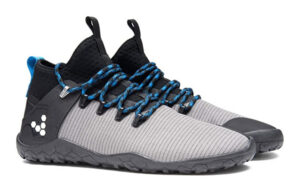
The Magna Trail is more a minimalist shoe in that the sole tends to be a little thicker but it stills retains its flexibility. It also comes with a removable thermal insole which I have kept in to add a bit more comfort. As this was my first foray into barefoot shoes, I wanted to take it a little slow. The main outer shell is completely water resistant and the flexible sock at the top provides a snug fit. The top lacing holes are designed to give a natural heel-lock design (although I still do the heel-lock lacing because the laces are so long). Vivobarefoot’s flexibility means you can smoosh all of their shoes into a very small shape. This is particularly useful when traveling as, with the help of a luggage strap, I can squeeze these shoes down to a minuscule 12″ x 4.5″ x 4.5″ footprint in my luggage (incidentally my jikatabi sneakers can get down to an even smaller 12″ x 4.5″ x 3.5″ footprint). I normally travel with just a backpack and a small carry-on suitcase so every bit of space counts for me. My old Timberland hiking boots would take up an enormous 12″ x 5″ x 8″ footprint or 25% of my suitcase space. I would often wear them while flying just to avoid having to pack them.
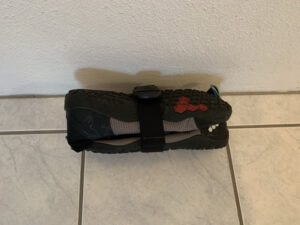
I was able to fully test out the shoes a few months later while sightseeing in downtown Atlanta, Georgia. I should note that the compression sock at the top of the shoe does mean it can be difficult to put on, but it ensures a snug fit presumably to keep pebbles and rocks out while trail hiking. The thicker sole and thermal insole also means that this is not as drastic a transition from regular shoes. While walking around various attractions for half a day my only complaint would be that the material on the instep above my big toe knuckle would sometimes gather and pinch and rub. It didn’t happen often but I would have to smooth out and adjust the material to prevent any blistering. Since then I have used them in torrential rain downpours without getting my feet wet. Previous hiking boots I have owned would only stand up for so long in heavy rain before water would begin to seep through. I have since which used them in the Argentinian country-side just outside of Buenos Aires, hiking the muddy Cerro Alarken Nature Reserve in Ushuaia, Argentina and walking around the rugged terrain of The Falkland Islands.
Seven months later I felt comfortable upgrading my black work shoes with a pair of Vivobarefoot Primus Lux Leather. Ironically enough my previous work shoes were a pair of 8-year-old extremely light weight Clarks (the predecessor to their Un Abode Go line).
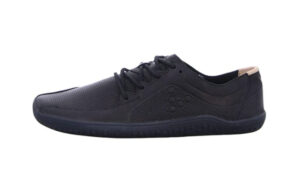
The Primus Lux Leather is really a leather trainer (British term for sneaker) but the leather finish makes it suitable enough for use as a semi-casual work shoe. Out of all of my shoes, this pair is a true barefoot shoe. There is only the thinnest of leather insole and TPU outsole (thermoplastic polyurethane). You will feel everything underneath your feet. While I only use my pair for office work, I wouldn’t recommend using these as running shoes without a lot of breaking in and training in barefoot running. These shoes are very enjoyable to wear as they are easy to slip on and fit my feet like a glove. They are only slightly uncomfortable when I have to walk on a rough asphalt or gravel parking lot as you can feel every stone and pebble poking the bottom of your feet. The thicker sole of the Magna Trail avoids this sensation. Because this is a work shoe, it is not an issue for me.
After another seven months I was ready to upgrade my brown pair of work shoes for another pair of Vivobarefoot shoes. Although my previous pair of brown Sketchers were only a little over 6 years old, I was hooked on the minimalist shoe feeling at this point. This time I went with the pair recommended on Practical Wanderlust – the Vivobarefoot Gobi II.
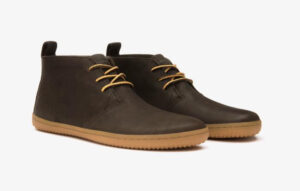
This desert boot is made from Wild Hide leather which almost has a suede like feel. The 3mm foam and cork insoles provide natural anti-bacterial and odor resistance in the event you want to wear them without socks. These shoes fall between the Magna Trail and Primus Lux in regards to barefoot feel. I did have to break them in the first few times I wore them as the back of the shoe would rub against my Achilles tendon. These shoes have the look of a Doc Martens desert boot but with the benefits of a minimalist shoe. They actually reminded me of some of the hand-crafted shoes I saw in Namibia in the Oshetu Community Market. One vendor had desert boots made from kudu and zebra leather with soles made from old car tires.
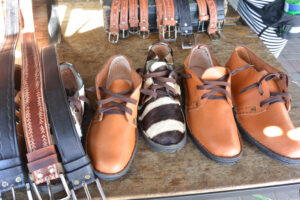

A single shoe for any of the Vivobarefoot shoes I have purchased weigh no more than 10 ounces so they are extremely lightweight. It should be noted that Vivobarefoot shoes are very expensive, easily priced at nearly twice what you would pay for a similar shoe. As I am only two years in at this point, I will see how long and how well these shoes hold up especially considering the price you pay.
It should go without saying that minimalist and barefoot shoes are not for everyone. If you have weak arches or plantar fasciitis, you probably don’t want to wear minimalist style shoes. I have noticed that prior to wearing minimalist shoes, my feet were shoe shaped i.e. my toes were touching, specifically the big toe and second toe. A year after wearing minimalist shoes, I have pretty good toe splay with my big toe very much separate from the others and the rest of the toes not really touching as well. Wearing minimalist shoes is also very good for calf strengthening. Of the seven pairs of shoes I own, the majority are now minimalist shoes. The only exceptions are a pair of dress shoes, my pair of Air Jordans and a pair of Pumas.




